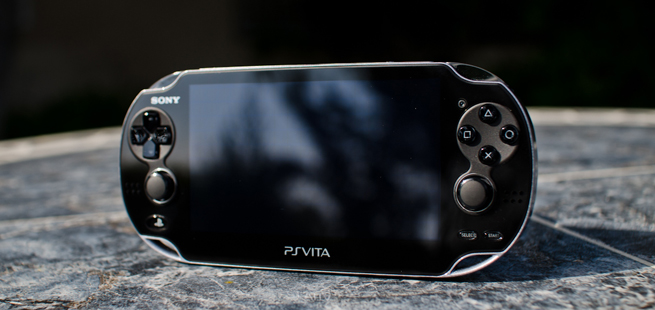
There is something extravagant about the release of a new game system: the promise of new and previously unheard of software experiences … hardware that is faster, better, and more capable. It is something that will be around for years and thus promises a level of quality generally reserved for far more expensive equipment.
But the times, they are a-changin’. Consumers expect more from electronics than ever before. Over 50% of Americans own smartphones that not only make calls but run applications and play games — they are quickly replacing standalone media players. Even Sony has experimented with a smartphone game system in the Xperia Play, which has found only limited commercial success.
Even amid fierce competition from products like the iPhone, Android smartphones, and tablets, there is still a burgeoning market for portable video game consoles. The Nintendo 3DS has sold over 15 million units worldwide in less than a year, making it the fastest selling video game machine in history. Can Sony match that success with the more expensive, better connected, and higher-quality PlayStation Vita?
Hardware and design
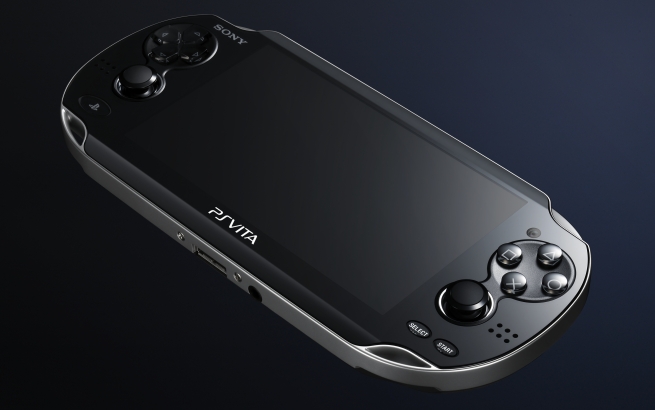
At first glance the Vita appears almost identical to the PSP. It shares nearly all of the PSP’s dimensions, but the Vita couldn’t be more different. It’s sleek, bold, and immediately stunning, unlike the plastic frame every PSP model has shared. The eye wants to look at the Vita’s gorgeous glass front, very crisp labeling, and expertly crafted controls.
The front of the Vita is almost exclusively made of glass, a design shared by Apple’s iPhone 4. The Vita doesn’t look like a kid’s toy; it looks like a serious gadget, a futuristic piece of technology. It isn’t soft around the edges nor does it feel childish. A plastic frame is glossy but easy to grip, and on the back are two finger rests to grip the Vita.
[vb_gallery id=393471]
From top to bottom the Vita looks and feels solid. I carried it around in a bag and pockets, and though the glass front did give me pause, the Vita is a stable device. It is huge (3.3″ x 7.2″ x 18.6″ h/w/d and 9.8oz), so don’t expect to carry it in tight jeans or small bag pockets. The build quality is very high, and I had no trouble or worry when holding it in a pocket.
The Vita has a very similar control layout to the PSP and DualShock controller: a D-pad and analog stick on the left, four face buttons on the right, as well as a PlayStation (home/return) button, start and select buttons, two shoulder buttons, volume controls, and power. The Vita is the first portable game system with a second analog stick, which makes traditional home-console-style titles easier to play on the Vita. Nintendo’s 3DS will receive an attachment with a second analog stick, but the Vita has two unique features over the 3DS: a 5″ OLED touchscreen display and an equally large rear touchpad.
Display
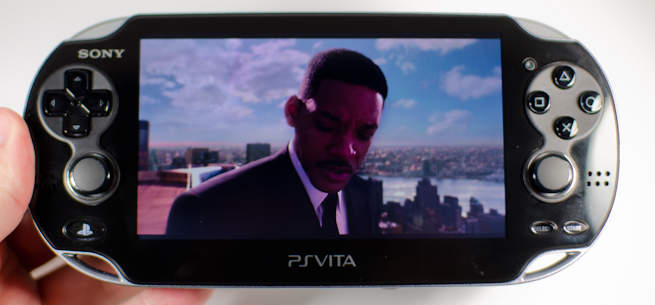
The Vita has an OLED display. Not AMOLED, not Super AMOLED, and not any of the other OLED technologies many companies are touting. This seems like a questionable design choice; although Sony first brought OLED into the home with the 11″ XEL-1 TV, OLED displays have been consistently lambasted for a lack of visibility outdoors.
Solutions used by LG and Samsung address that problem in recent smartphones but don’t solve it entirely. At CES Sony engineers I spoke with said that OLED technology is inferior to LCD panels for several reasons: the lack of brightness, inaccurate colors due to over-saturation, and a blue hue to the screen. That’s why the upcoming Xperia S and Xperia Ion will both come equipped with LCD displays. The Vita, by comparison, seems to have a plain old OLED. Sony isn’t marketing it in any other way.
It certainly isn’t plain.
The 960×544 display is one of the most beautiful and vibrant I’ve ever seen and is certainly the best in its size. It isn’t dense at 220ppi (the iPhone’s Retina Display is 326ppi, the HTC Rezound is 342ppi), but for gaming and video it is dense enough. Nearly every problem with OLED displays is gone, eliminated in some way that Sony has not discussed publicly. I’ve tested the display indoors and out and am extremely impressed with both color accuracy and brightness. The only trouble is in direct sunlight, not because the pictures on-screen aren’t visible, but because fingerprints and smudges block the screen. The display doesn’t appear to have an oleophobic coating, so cleaning the screen to better see in direct sunlight is difficult.
It’s an absolute pleasure to view anything on the Vita’s display. Pictures and video are crisp and very clear — more so than on any smartphone or tablet. Games are reproduced on the display in the best possible light, likely better than most TVs can muster. I can’t recommend using the Vita instead of an iPad or Android tablet for watching videos — bigger is better, of course — but if the choice is gaming and watching movies on one or the other, the Vita wins hands down. The 5″ panel on the Vita is extraordinary.
Continue reading for internal components…
Internal components
In today’s yearly update cycle, prevalent in both smartphones and tablets, game systems are seriously antiquated. The PSP was released back in 2005 in the US, nearly seven years ago, and the Nintendo DS just a few months earlier. At the time both consoles were considered powerful, but Moore’s Law quickly changed that. Today, the Vita ships with a quad-core ARM Cortex A9, 512MB of RAM, and a PowerVR graphics processor with 128MB of video RAM. This hardware will likely be overshadowed by phones and tablets in two years, if not sooner, and will be considered old in three.
Because apps are not yet downloadable to the Vita, and there are limited benchmarks I can perform (due to the Vita’s unique operating system and the newness of the hardware), I’ll briefly discuss the internal components compared to other devices.
The CPU is very similar to what is found in many smartphones today. The iPhone 4S uses a dual-core ARM Cortex A9, compared to the Vita’s quad-core A9. My research indicates that the Vita’s processor is capable of reaching up to 2GHz but averages 800MHz. This is to conserve battery life; running at 2GHz would run down the battery within an hour and a half. It’s unclear whether Sony has locked in the CPU at 800MHz for developers until a future date as it did with the PSP (which originally was locked at 222MHz until two years after its initial release, when Sony released a firmware update that opened the processor up to 333MHz).
512MB of RAM matches the Xbox 360 and is slightly more RAM than the PlayStation 3. It’s also half the RAM of most of today’s high-end smartphones.
The PowerVR GPU (a SGX543MP4+) is a quad-core video processor and is an upgraded version of what’s inside the iPhone 4S and iPad 2, with twice as many cores and additional clock speed. By March or April I expect Apple to announce its next iPad with a similar GPU. That gives the Vita at least one year as the top dog.
The Vita also includes a SIXAXIS motion sensor like the one found in the PlayStation 3’s controllers, as well as an 802.11 b/g/n Wi-Fi antenna, an HSPA+ antenna for 3G data speeds, Bluetooth 2.1, and two VGA (640×480) cameras. The Vita has no internal memory, and without a specially made PlayStation Vita card, users can’t buy games online. However, games are sold as cartridges and saves can be stored on the games themselves.
Camera
Like the Nintendo DS, the Vita has a rear and front VGA camera, and like the DS and newer 3DS, the camera is terrible. In both good and bad conditions the Vita took shots akin to the Motorola Razr. Not the new Droid Razr, the 2004 original. The 0.3MP cameras are just awful, as you can see below. We’ll take a closer look at camera quality later on, but for now don’t expect to take better photos with the Vita than any camera or phone that’s come out in the last five years.
The Vita is not intended to be used for still shots, though it has that function. The rear camera is intended for augmented reality, and the front camera is for potential VoIP apps like Skype, which have been available on the PSP. Both cameras are fast enough to deliver those functions, though as of press time augmented reality games and apps are not available.
Sound quality
Speaker placement has been a regular problem on Sony’s portables. The Vita’s stereo speakers are directly beside the analog sticks and are significantly larger than the speakers on the PSP. In all of my testing I consistently blocked the speakers with my thumbs. This muffles sounds, but is generally not problematic.
Sound quality on the Vita is good, not great. Tones are clear, though some sounds are hard and sharp and can be painful. The Vita doesn’t get very loud, and even at full volume it’s difficult to hear in noisy environments. Sound reproduction is generally accurate, but not always pleasant. I highly recommend using either Bluetooth or wired headphones, especially for gaming, because it is too easy to miss in-game sound and music.
Inputs, storage, and 3G
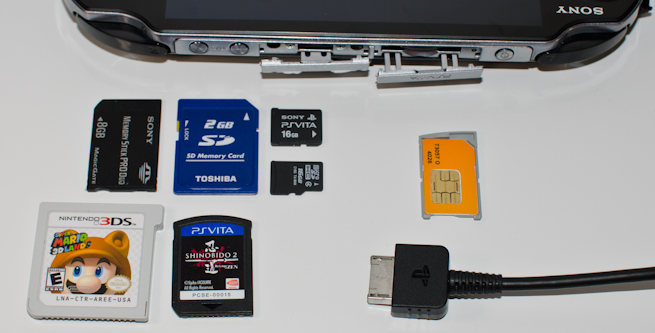
The Vita is fully equipped to connect to computers and the Internet. It has a proprietary USB connector that acts as a charging cable and data connection to a PC (Windows or Mac) or a PS3. The connector is not the same as the PSP Go’s proprietary USB connector, and it will only work with the Vita. There is no reason for Sony to have a proprietary USB cable, so if you lose it, you have to buy a replacement.
There is also an unmarked connector on the top of the Vita, likely for future hardware attachments. The PSP had a USBMini port, which was later used for a camera in Japan. The Vita has a 3.5mm auxiliary audio jack that supports stereo out but doesn’t support a microphone.
Two storage options are available for Vita owners: the previously mentioned PlayStation Memory cards and physical games. The former comes in four sizes: 4GB, 8GB, 16GB, and 32GB, and ranges from $20-$100. The latter is simply the game cartridge, which can have games saved directly to it. Physical games do not require internal memory to play. Without a PlayStation Memory Card, however, the Vita cannot download from the PlayStation Store or store any data on the Vita.
Furthermore, individual flash cards are attached to individual PlayStation Network accounts. That means users cannot share memory cards with friends, so if you’re sharing a Vita, you must have your own flash memory. Removing the memory card will cause the Vita to reboot. The only way to switch the account on the memory card is to reformat it, thereby deleting all data on it. Because the PlayStation Memory cards can only be used with the Vita, the Vita is the only device that can do this, though data can be backed up to a PC or PS3.
The 3G Vita model (tested, $299) can access HSPA+ networks, which is the faster “4G” that AT&T and T-Mobile tout for most smartphones today. However, the antenna built into the Vita supports 14.4Mbps, half of the maximum on many of today’s smartphones. This limits the overall data speed to 4Mbps down, compared to the more standard 28.8 compatible chips, which generally have data speeds hovering around 8Mbps down.
In my testing around Los Angeles the Vita was able to maintain a strong connection in nearly all areas with 4Mbps down and 1Mbps up. This amount of data speed was consistently more than enough to view Maps data, browse the web, use web-based apps like Near, though online gameplay and Remote Play are restricted to Wi-Fi networks. I tested streaming gaming through OnLive’s service, but it’s doubtful that the Vita would be able to match that same quality with only half the bandwidth.
The Vita is locked to AT&T. I tried using a T-Mobile SIM card, but the Vita listed it as an “invalid SIM” and removed all 3G options from the settings. Removing the SIM will force a reboot.
Continue reading for software…
Software
 The Vita is Sony’s first PlayStation product in a decade that doesn’t use the company’s longtime XrossMediaBar user interface, a solid line of various folders that is easy to navigate. As PlayStation 3 owners know, with the proliferation of apps and extended functionality of the console, XMB is cumbersome and takes time to scroll through. The new UI, dubbed LiveArea, is familiar to Android and iOS users, utilizing pages of apps that are accessible via the touchscreen.
The Vita is Sony’s first PlayStation product in a decade that doesn’t use the company’s longtime XrossMediaBar user interface, a solid line of various folders that is easy to navigate. As PlayStation 3 owners know, with the proliferation of apps and extended functionality of the console, XMB is cumbersome and takes time to scroll through. The new UI, dubbed LiveArea, is familiar to Android and iOS users, utilizing pages of apps that are accessible via the touchscreen.
LiveArea is extremely simple. A child who knows nothing about video games can pick it up and go through the menus instantly. PSP owners may have to adjust from the previous standard. The only way to navigate, though, is by using the touchscreen, which because of the Vita’s large size, isn’t always inconvenient. Sony did an excellent job of creating a high-speed joystick-based UI with the PSP and PS3, and for players who don’t want to take their hands off the controls, simple navigation can be a nuisance.
Basic applications in LiveArea include the following:
- Settings, can be activated anytime to adjust brightness, network settings, etc.
- PlayStation Store, for purchasing and downloading games, demos, and movies
- Welcome Park, a built-in virtual guide with tutorials
- Friends, a list of all your friends and their game statistics
- Near, a location-based app that finds Vita owners near you
- Party, an in-console communication app to speak with other Vita users (via voice)
- Group Messaging, a basic messaging app for friends
- Trophies, a list of your and friends’ achievements
- Photos, the camera and photo-viewing app
- Network Operator, shows data usage and allows for billing and payment
- Browser, a non-Flash browser that supports HTML5 and Javascript
- Remote Play, enables users to connect wirelessly to their PS3
- Maps (Google Maps), with GPS functionality that can relay traffic
- Content Manager, for managing all media to and from the Vita from a PC or PS3
- Music, the music player that supports MP3, MP4, and WAV files; can play in the background while gaming
- Videos, the video player for rented movies and downloaded videos; supports MP4 and H.264 filetypes
This poses an immediate problem: The Vita ships with 16 apps, which floods the first and second page of LiveArea. There’s something to be said for simplicity, but media apps like Music, Videos, and Content Manager can all be one. Friends, Party, Trophies, Group Messaging, and Near can all be one. Welcome Park doesn’t even need to be an app and can be a simple settings feature. The Vita ships with bloatware, and all of it is from Sony. Ironically, they do so to keep things simple.
LiveArea has several major annoyances. The first is the two-step process to open any app. If you want to play a game, tap on the game app, then a “Live Window” will appear with a big button that says “Start.” Many apps have secondary options at this step. The window can show other features like the game’s documentation, a direct link to the app’s website, add-ons, etc. The Videos app does this especially well, with small images of films available for rent or purchase, which when clicked will take users to the movie’s page in the Videos app. However, this two-step action should be a player choice, not a requirement, and slows users down from getting in the game or app.
LiveArea is also home to elevator music. When in the LiveArea, between apps or when bouncing out of a game to change settings, the Vita will play one of the most abrasive tunes ever. At first it sounds alright, but over time it becomes irritating to the point where I had to mute the Vita whenever in LiveArea, lest I pluck my own ears off. (Update: You can also turn this permanently off in the settings, under “Sound and Display.”)
Right now LiveArea is easy to use, but it lacks organization, and Sony clearly didn’t care about consolidating apps. It almost sounds like a prank gone wrong that the Vita ships with 16 different apps — none of them games themselves — and only five have anything to do with gaming whatsoever.
The keyboard
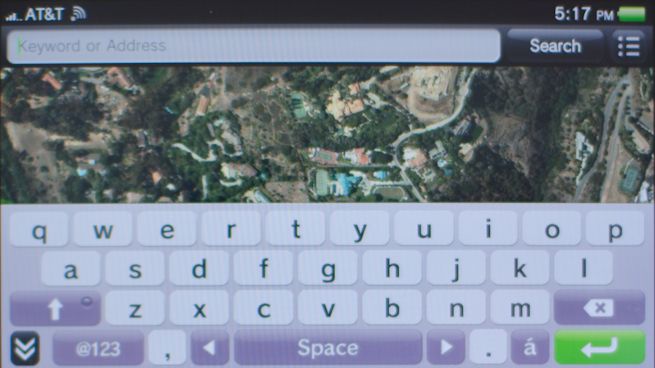
The virtual keyboard on the Vita should be very easy to use, considering the 5″ display. There’s just one problem: The sides are wide and reaching the middle of the touchscreen is difficult for all but the largest of hands.
Using the keyboard to type is almost equivalent to typing on a tablet with just thumbs while holding it in portrait. The Vita is simply too large to reach the center keys easily. The spacing isn’t even, and the entire keyboard favors the right side for the bottom two rows. This means it is easier to reach the G, V, and B keys with the right hand than it is with the left.
However, the keyboard is very accurate, and besides for the odd key placement and distance for middle keys I rarely made errors while typing. The keys are all large and spacious, and it’s easy to type quickly. Furthermore the number keys are all assigned to the right side, much like a number pad, which is far more convenient than today’s smartphones and tablets. Phone makers should take note.
The one great irony is that the Vita’s keyboard can be fixed in one easy step: by making it available in portrait. The Vita is a landscape device, so to speak. It’s long on the sides. Holding it vertically may squeeze the keys together, but even then it’s still a very large keyboard with plenty of room for all the keys, and no pesky controls in the way to block thumbs. No such option is available.
Continue reading for the browser…
The browser
Considering how powerful the internal components of the Vita are, the browser shouldn’t be nearly as bad as it actually is. The Vita’s browser, to be clear, is one of the worst available on any device manufactured within the last five years. That statement may be generous. With the exception of other portable devices, no browser I’ve ever tested is as slow and frustrating as the Vita’s.
I ran two industry-standard benchmarks on the browser, which you can see below. The Vita scores worse than tablets and smartphones. It scores worse than devices with significantly cheaper internal components. Hell, it scores worse than an eReader — and one of Sony’s own, no less!

Above: Higher is better for Browsermark, lower is better for Sunspider. Today's smartphones average around the iPhone 4S' scores.
In practical use, the browser is usable but very slow. It loads pages all at once after 5-10 seconds of downloading instead of showing the page immediately, and it doesn’t support Flash or HTML5 video. HTML5 is supported, but by using the browser you wouldn’t know it. HTML5 rich websites are extremely slow and so difficult to navigate that it isn’t worth it. I logged into Gmail and it took five minutes just to open an email, read it, and send a one-line reply. And it couldn’t even do that. Artifacts on the page would randomly disappear or not work, the zoom function would stop working or completely disregard my commands…the browser is a real mess. It’s far easier to use a dumbphone’s browser than this.
The only potential use I can see in the browser is to have easy access to a game guide or something to do with the game you are playing. The problem is multitasking on the Vita is so negligible that the browser can’t be open at the same time as a game. If you’re stuck on a part and want to look up how to defeat that boss or solve that puzzle, the Vita forces users to quit the game to open the browser. That’s not even funny.
Remote Play
As of today, Remote Play is almost entirely useless for gaming on the Vita. The overwhelming majority of PS3 games will not play streaming to the Vita, though the Vita (unlike the PSP) has the controls to do so. This will (hopefully) change in the near future.
Maps
Google Maps on the Vita is almost useless because of how slow the service is over a solid 3G (HSPA+) network. Even with the maximum download rate it is so slow that by the time you get traffic details you’ll have been sitting in traffic for five minutes.
Over a Wi-Fi network I had no trouble quickly seeing maps, traffic, and location data. It’s still slow but usable over Wi-Fi. The compass works extremely well, far better than any smartphone I’ve ever tested. Even then, however, I wouldn’t recommend using the Vita for navigation. Driving and using the Vita for navigation is just ludicrous, but if you’re walking down the street and using it for guidance, just tape a note on your back that says, “Steal my Vita!”
Content manager

Above: The Content Manager Assistant on the PC is just this and an icon in the user dock
I don’t know how long it’s going to take for a company that isn’t named Apple or Microsoft to figure out content management. Sony clearly doesn’t get it. The current Content Manager is terrible, an awful application that isn’t simple or convenient in any way. The way it works is like this: Plug the Vita into a PC/PS3, and use the Vita to navigate through media you’re interested in transferring through pre-selected folders. If the media isn’t in those folders, unplug the Vita, move the files to those folders, and repeat the process.
Content Software Assistant, the PC application that handles the data transaction, is the worst attempt at data transfer to a device I’ve ever seen. It shows just how terrible Sony can be at building decent software. Transferring music, movies and pictures isn’t worth the trouble of rearranging your data on your computer to meet the requirements of the application. And frankly, being forced to do so just to watch a movie I already own is a travesty.
Sony could have easily remedied this with an actual, honest-to-goodness software application. They did so (eventually) with the PSP. We’re at the point where media we own can be streamed and downloaded wirelessly. Meanwhile, the Vita is stuck in 2005.
Continue reading for gaming…
Gaming
Gaming on the Vita is an all around excellent experience. Thanks to very tight controls and that beautiful display, there is no better way to play portable games than on the Vita.
Controls

As mentioned in page one, the controls on the Vita are a blend between the DualShock controller and PSP. The feel, however, is entirely different and vastly improved.
The D-pad, which has always been a single solid piece connected under the frame, is now a solid piece that users can feel all the way through. This makes it easier to feel and much easier to switch between opposite directions quickly, though it’s also a tad too small. The face buttons are smaller than on the PSP or DualShock, about the same size as the PSP Go, but also much taller. They click when pressed, which provides much clearer feedback for users than the PSP’s rubberized buttons. The higher-profile buttons are also easier to press.
In fact, all of the buttons have a more mouse-button like feel, where when pressed they click. Not only is that click heard, it’s felt, so players know they pressed the button. Even the start and select buttons, which are more difficult to press because they are sunken into the Vita’s frame, click when pressed. The two shoulder buttons are easy to reach and press, and are practically identical in feel and size to the PSP.
The rear touchpad is both easy to use and misuse. Several launch release titles utilize the rear touch panel, including Super Stardust Delta and Mutant Blobs Attack!!!, and the functionality works well in many ways. However, sometimes it doesn’t. As a button, which Delta uses, the touchpad gets in the way and activates more as an accident than on purpose. The hardware itself is sound, but it will take time for developers to fully realize its potential.
Finally, the analog sticks. They are a huge departure from the PSP’s analog stick design, which was conservative in a way to keep it from breaking. The Vita’s sticks are much more pronounced, and stick out a centimeter off of the Vita’s body. It looks like they can snap off easily, but over the past week of use they have remained not only perfectly intact, but completely functional. I put unreasonable amounts of force on both, pulling and pushing them harder than any game would require (and I do not recommend doing this yourself), and the both analog sticks are completely functional. The Vita itself creaked from the excessive force, but overall the joysticks are stable as a rock. And having that extra height provides a more natural feel when using the analog sticks.
Gaming and general performance
As of this writing, there are 18 games available for purchase on the Vita. Most are not demanding graphically, though some titles like Uncharted: Golden Abyss test the current limits of the console. In my time playing with the Vita I never once encountered slowness in any games tested (12/18 games available), and colleages and friends agree that the Vita is extremely stable and fully capable as a game console. I have found no difficulty with game controls, no slowness while playing individual titles, and no performance drops whatsoever.
However, I have found minor reports of some heavier games experiencing minor performance drops, including Uncharted later in the game. Some PSP titles that are available on the Vita have also reportedly caused the console problems, ranging from slight performance drops to locking the console for nearly 20 minutes. The latter is rare, and I have only found one case of such occurring, though as mentioned above there are some software issues that Sony needs to sort out.
Overall, playing Vita games is an exceptional gaming experience.
I also tested several PSP games on the Vita, and every one provides an equally good experience. Games take up the full display, though they are pixelated. Unfortunately the list of available games is small, so many PSP games you own may not be available for the Vita. At least not yet. There is no way to transfer UMD games to the Vita either, and Sony has not announced any way to do this in the future.
Battery life and power
The Vita has a built-in 2210mAh battery, which is around 500mAh larger than today’s average smartphone. That extra power for the faster processor and significantly larger screen. I’ve tested the battery life on the Vita extensively, though haven’t fully completed my testing. As of press time, the average time of gameplay is about 5.5 hours with 3G off, and about five 5 hours with 3G on.
So far I’m very impressed with the battery life, though the way the Vita handles power is often puzzling. Like most electronics today it has a low-power standby mode, though two times during testing the Vita came out of standby on its own and drained the battery entirely. Once this occurred when in my pocket, and the other time was on my bedstand overnight.
Charging time is exceptional, only an hour and a half from a near-complete discharge (using the included power adapter). However, like the PSP the Vita cannot play games at a certain level of low power, even if it’s immediately plugged in after going into a low-power state. It requires 5-10 minutes of charging before the Vita can be activated again. Some reports have claimed that the Vita does not charge when in-game. This is not true. The Vita will charge the battery whenever plugged in.
My biggest problem with the Vita’s power is the lack of a number percentage of battery life remaining. There is a battery icon that graphically shows how much power is remaining, but there is no indicator anywhere in the Vita that shows how much power actually remains or an estimate of how long before the battery runs out of power.
Continue reading for the conclusion…
The conclusion
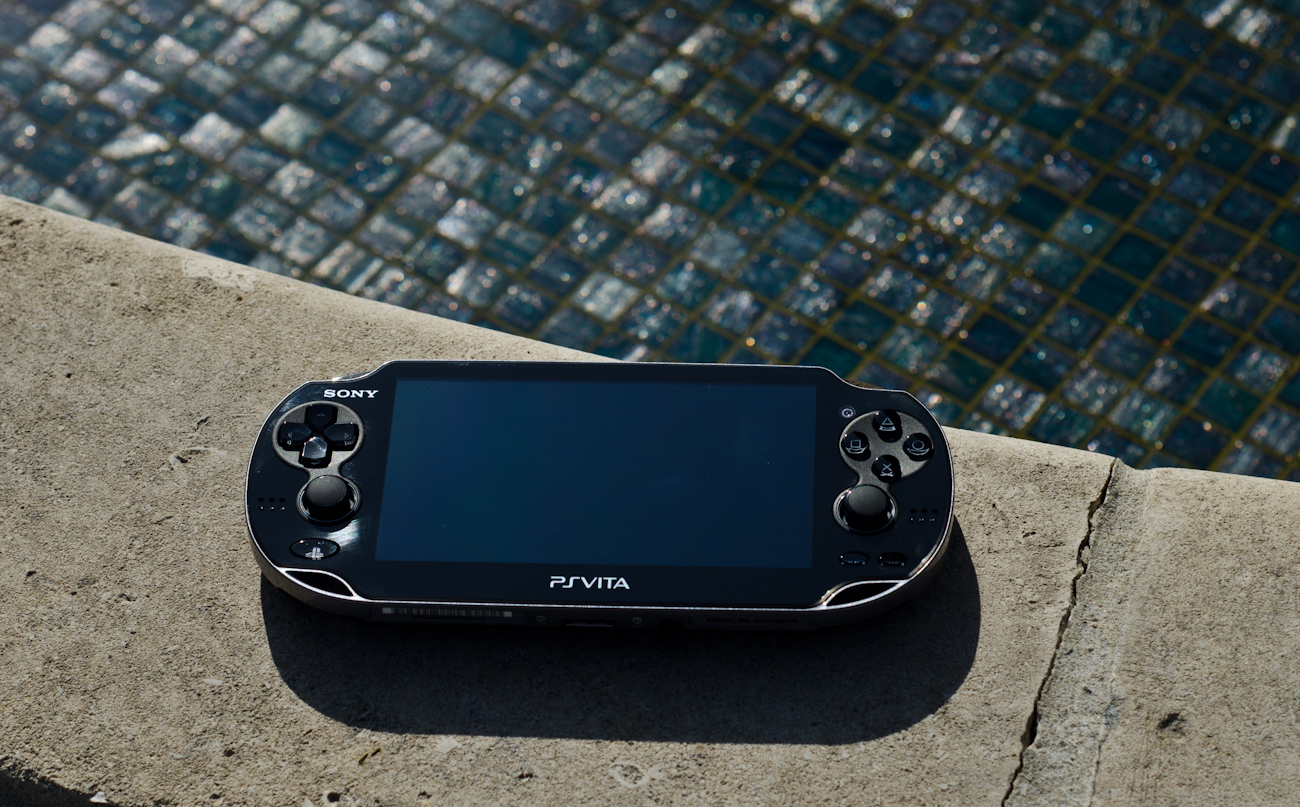
When Sony announced the Vita, I was skeptical. Smartphones, to me, are the future. But numbers don’t lie, and people love portable game systems.
After testing the Vita, I can see why. The Vita is an extraordinary piece of equipment, far better than any smartphone or tablet for gaming. Not because it offers “full feature” titles like Uncharted: Golden Abyss and Ultimate Marvel vs. Capcom, and not because it has physical controls. The combination of those things, along with a brilliant display, smart user interface through the combination of physical and touch controls, and excellent build design make the Vita a wonderful gaming device.
But just a gaming device. Every non-gaming feature on the Vita is lacking and often severely. The camera is flat-out terrible, the content management system is frightfully bad, the browser is worse than Internet Explorer 1.0, and LiveArea does a better job annoying users than acting as the Vita’s home menu. There’s so much wrong with everything non-gaming about the Vita that it looks like a team of amateur software engineers baked it in a garage.
The hardware itself is absolutely stunning. The Vita has the looks and the feel, and even though it’s large, over the entire testing period I didn’t care about the extra bulk. I was and remain willing to carry it around for gaming. As good as the hardware and gaming implementation is, that’s how bad the non-gaming apps and software are in almost every way.
Thankfully, over 50% of Americans today already own smartphones. So all those extra functions that the Vita ships with don’t really matter; they’re all already available. While we don’t rate hardware, I can safely say that anyone who plays games on the go will not only enjoy, but love the Vita. It is the best portable ever conceived. Just don’t expect to do much with it besides for gaming.
VentureBeat's mission is to be a digital town square for technical decision-makers to gain knowledge about transformative enterprise technology and transact. Learn More
